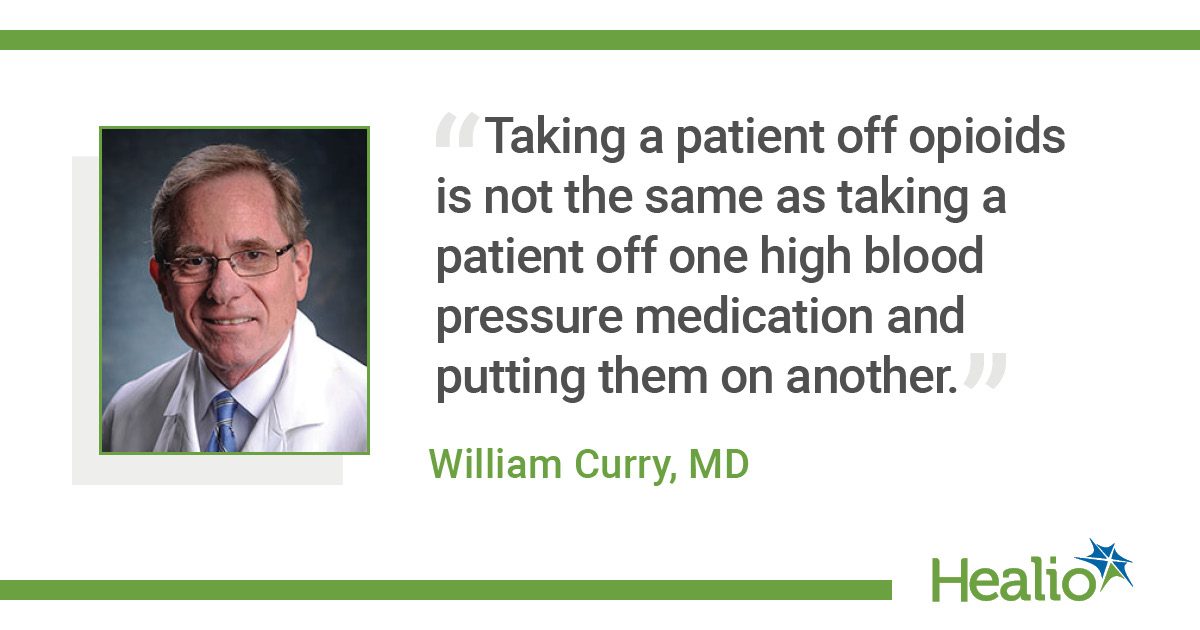Physicians tapering patients off opioids can turn to HHS guide
A recent study suggests that less than a quarter of patients on chronic opioid therapy for noncancer pain are tapered off opioids, and another study found that only 35% of patients are able to successfully do so.
“Taking a patient off opioids is not the same as taking a patient off one high blood pressure medication and putting them on another,” William Curry, MD, the associate dean of rural and primary care at the University of Alabama at Birmingham, told Healio Primary Care.
The challenge of tapering can be daunting, but a new HHS guide may help physicians move patients off opioids safely. The new guide focuses on individualized care, according to Adm. Brett P. Giroir, MD, the HHS assistant secretary for health.
“We need to treat people with compassion and emphasize personalized care tailored to the specific circumstances and unique needs of each patient,” Giroir said in a press release.

HHS recommendations
According to the HHS guide, common tapers involve dose reductions of 5% to 20% every 4 weeks. Patients who are candidates for opioid tapering are those who:
- ask for a dosage reduction or discontinuation;
- indicate their pain has improved;
- do not benefit from higher doses of opioids;
- display current evidence of opioid misuse;
- experience adverse events that lower quality of life or inhibit function;
- experience an overdose or other serious event or exhibit warning signs of an imminent event, such as confusion, sedation or slurred speech;
- receive medications or has medical conditions that increase risk for adverse outcomes; and
- were treated with opioids for an extended period and the current benefit/harm balance is unclear.
The guide stresses that the decision to taper should be a collaborative one between the physician and patient.
“Without that, dose reduction is very unlikely to work,” Curry said.
According to HHS, physicians should not demand that patients taper off opioids or stop their use when opioid use is justified — for cancer pain or pain at the end of life, for example.
There are important steps that physicians should take before tapering a patient off opioids, according to HHS, including:
- committing to working with patients to improve function and decrease pain;
- being prepared to treat comorbid mental disorders like depression, anxiety and PTSD;
- offering to arrange a consultation with a behavioral health provider if a patient has serious mental illness;
- assessing the patient for opioid use disorder using DSM-5 criteria;
- seek out health professionals with the appropriate expertise if considering opioid tapering or managing opioid use disorder during pregnancy; and
- counseling patients that there is an increased risk for overdose if they abruptly return to a previously prescribed higher dose.
These are all valid points, according to Curry.
“The guide very rightly points out the need to see the patient frequently to watch for signs of withdrawal or suicidal thinking,” he said.
Tanja Johnson, FNP, MSN, BSN, an integrative addiction and chronic pain specialist in Colorado, told Healio Primary Care that the HHS guide does not mention specific behavioral patterns that would be helpful for physicians to be mindful of as they monitor patients who are tapering off opioids.

“Clinicians should ask patients how many hours of sleep they are getting, how many arguments are they getting into with co-workers, family members and friends and how they are functioning at home and work,” she said, adding that these answers should then be compared to the patients’ behavior before the taper began to gauge their progress.
Johnson said the guide might have also benefitted from mentioning that there are opioid use disorder specialists or chronic pain specialists who can provide support to tapering patients, but in most ways, “HHS is on point” in providing much needed guidance to help physicians help their patients taper off opioids.
Both Curry and Johnson told Healio Primary Care that the guide’s approach is the right one.
“I like their examples of how to taper slowly and going even more slowly, if necessary, to keep the taper going — even briefly going back up on a dose if that’s necessary because of the circumstances,” Curry said. “There has to be flexibility in a situation as complicated as chronic opioid therapy.”
“The HHS guide advises considering slow tapering for the best outcomes and using buprenorphine-based products,” Johnson added. “Based on my experience, HHS hit that right on the mark.”
Curry said the CDC’s guidance on opioid prescribing is helpful, but there is evidence that the agency’s recommendations have been misapplied in the medical community. He recommended using the CDC guidance in conjunction with the HHS guide, which “provides some good balance about how to taper safely and effectively.” – by Janel Miller
References:
Austin RC, et al. Fam Med. 2019;doi:10.22454/FamMed.2019.502.509.
HHS. Guide for clinicians on the appropriate dosage reduction or discontinuation of long-term opioid analgesics. https://www.hhs.gov/opioids/sites/default/files/2019-10/8-Page%20version__HHS%20Guidance%20for%20Dosage%20Reduction%20or%20Discontinuation%20of%20Opioids.pdf. Accessed Oct. 18, 2019.
Manhapra A, et al. Subst Abus. 2018;doi:10.1080/08897077.2017.1381663.
Disclosures: Giroir and Curry report no relevant financial disclosures. Johnson reports past speaking engagements related to this story’s topic.

